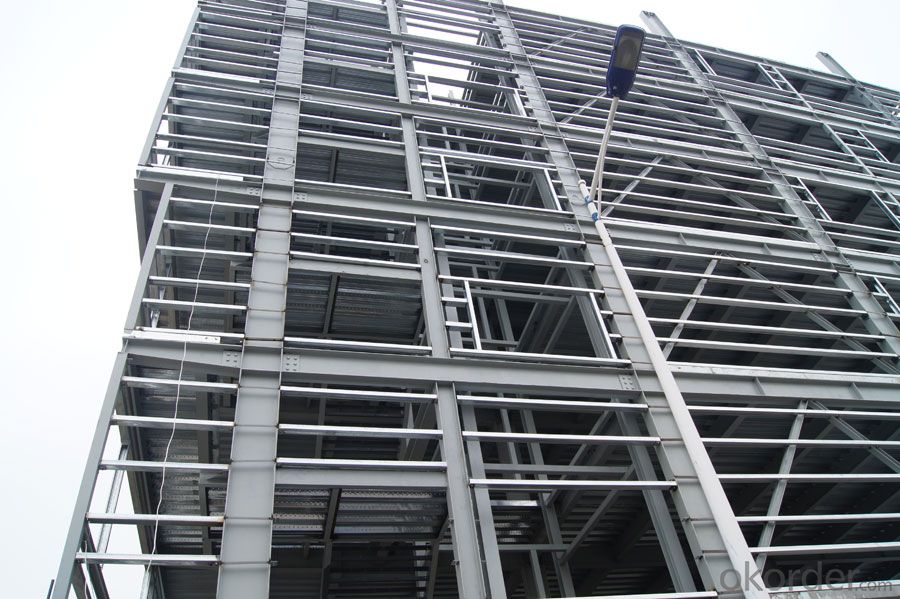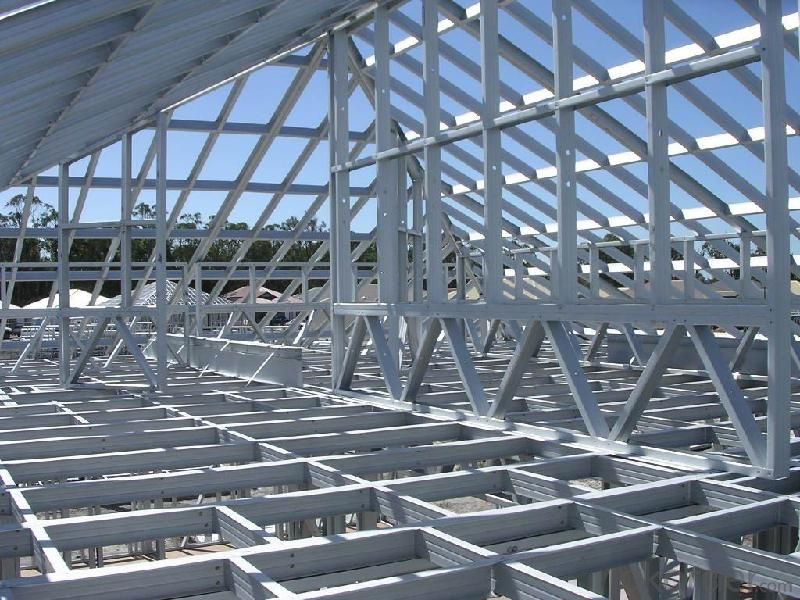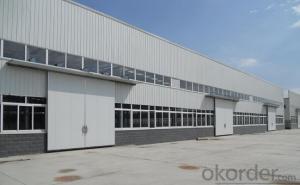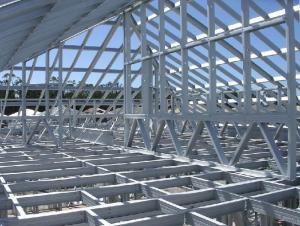Steel Structure for Building and prefabricated house
- Loading Port:
- China Main Port
- Payment Terms:
- TT or LC
- Min Order Qty:
- -
- Supply Capability:
- -
OKorder Service Pledge
OKorder Financial Service
You Might Also Like
Product Description:
OKorder is offering steel structure at great prices with worldwide shipping. Our supplier is a world-class manufacturer of steel, with our products utilized the world over. OKorder annually supplies products to European, North American and Asian markets. We provide quotations within 24 hours of receiving an inquiry and guarantee competitive prices.
Product Applications:
1. Heavy industrial plants: relatively large span and column spacing; with a heavy duty crane or large-tonnage cranes; or plants with 2 to 3 layers cranes; as well as some high-temperature workshop should adopt steel crane beams, steel components, steel roof, steel columns, etc. up to the whole structure
2. Large span structure: the greater the span of the structure, the more significant economic benefits will have by reducing the weight of the structure
3. Towering structures and high-rise buildings: the towering structure, including high-voltage transmission line towers, substation structure, radio and television emission towers and masts, etc. These structures are mainly exposed to the wind load. Besides of its light weight and easy installation, structure steel can bring upon with more economic returns by reducing the wind load through its high-strength and smaller member section.
4. Structure under dynamic loads: As steel with good dynamic performance and toughness, so it can be used directly to crane beam bearing a greater or larger span bridge crane
5. Removable and mobile structures: Structure Steel can also apply to movable Exhibition hall and prefabricated house etc by virtue of its light weight, bolt connection, easy installation and uninstallation. In case of construction machinery, it is a must to use structure steel so as to reduce the structural weight.
6. Containers and pipes: the high-pressure pipe and pipeline, gas tank and boiler are all made of steel for the sake of its high strength and leakproofness
7. Light steel structure: light steel structures and portal frame structure combined with single angle or thin-walled structural steel with the advantages of light weight, build fast and steel saving etc., in recent years has been widely used.
8. Other buildings: Transport Corridor, trestle and various pipeline support frame, as well as blast furnaces and boilers frameworks are usually made of steel structure.
All in all, according to the reality, structure steel is widely used for high, large, heavy and light construction.
Product Advantages:
OKorder's steel structure are durable, strong, and resist corrosion.
Main Product Features:
· Premium quality
· Prompt delivery & seaworthy packing (30 days after receiving deposit)
· Corrosion resistance
· Can be recycled and reused
· Mill test certification
· Professional Service
· Competitive pricing
Product Specifications:
Specifications of steel structure
Project: Jinan west railway station
Position: The Beijing-Shanghai high speed railway (Jinan)
Steel dosage: 5000MTs
Structure type: Box, tube, bending and twisting, transverse connection
1. GB standard material
2. High Structural safety and reliability
3. The production can reach GB/JIS/ISO/ASME standard
Packaging & Delivery of steel structure
1. According to the project design and the component size, usually the main component parts are nude packing and shipped by bulk vessel. And the small parts are packed in box or suitable packages and shipped by containers.
2. This will be communicated and negotiated with buyer according to the design.
Engineering Design Software of steel structure
Tekla Structure \ AUTO CAD \ PKPM software etc
Complex spatial structure project detailed design
Construct 3D-model and structure analysis. ensure the accuracy of the workshop drawings
Steel structure detail ,project management, automatic Shop Drawing, BOM table automatic generation system.
Control the whole structure design process, we can obtain higher efficiency and better results
Technical support of steel structure
Worker | Rate of frontline workers with certificate on duty reaches 100% |
Welder | 186 welders got AWS & ASME qualification 124 welders got JIS qualification 56 welders got DNV &BV qualification |
Technical inspector | 40 inspectors with UT 2 certificate 10 inspectors with RT 2 certificate 12 inspectors with MT 2 certificate 3 inspectors with UT3 certificate |
Engineer | 21 engineers with senior title 49 engineers with medium title 70 engineers with primary title. 61 First-Class Construction Engineers 182 Second-Class Construction Engineers |
International certification | 10 engineers with International Welding engineer, 8 engineers with CWI. |
Production Flow of steel structure/steel frame
Material preparation—cutting—fitting up—welding—component correction—rust removal—paint coating—packing—to storage and transportation (each process has the relevant inspection)
FAQ:
Q1: Why buy Materials & Equipment from OKorder.com?
A1: All products offered byOKorder.com are carefully selected from China's most reliable manufacturing enterprises. Through its ISO certifications, OKorder.com adheres to the highest standards and a commitment to supply chain safety and customer satisfaction.
Q2: How do we guarantee the quality of our products?
A2: We have established an advanced quality management system which conducts strict quality tests at every step, from raw materials to the final product. At the same time, we provide extensive follow-up service assurances as required.
Q3: How soon can we receive the product after purchase?
A3: Within three days of placing an order, we will begin production. The specific shipping date is dependent upon international and government factors, but is typically 7 to 10 workdays.
Q4: What makes stainless steel stainless?
A4: Stainless steel must contain at least 10.5 % chromium. It is this element that reacts with the oxygen in the air to form a complex chrome-oxide surface layer that is invisible but strong enough to prevent further oxygen from "staining" (rusting) the surface. Higher levels of chromium and the addition of other alloying elements such as nickel and molybdenum enhance this surface layer and improve the corrosion resistance of the stainless material.
Q5: Can stainless steel rust?
A5: Stainless does not "rust" as you think of regular steel rusting with a red oxide on the surface that flakes off. If you see red rust it is probably due to some iron particles that have contaminated the surface of the stainless steel and it is these iron particles that are rusting. Look at the source of the rusting and see if you can remove it from the surface.
Images:


- Q:What are the advantages of using steel structures in recreational facilities?
- There are several advantages of using steel structures in recreational facilities. Firstly, steel is a highly durable material that can withstand extreme weather conditions, ensuring the safety and longevity of the facility. Secondly, steel structures are highly versatile, allowing for flexible design options to accommodate various recreational activities. Additionally, steel is a sustainable and environmentally-friendly choice as it can be recycled and has a low carbon footprint. Lastly, steel structures are cost-effective, requiring minimal maintenance and repairs over time, making them a practical choice for recreational facilities.
- Q:How are steel structures designed for thermal bridging prevention?
- Steel structures are designed with various techniques to prevent or minimize thermal bridging, which is the transfer of heat through a material that is more conductive than the surrounding materials. One common method is the use of thermal breaks, which are insulating materials inserted between the steel members to interrupt the flow of heat. These thermal breaks can be made of materials like rubber, foam, or fiberglass, which have low thermal conductivity. Another approach is the use of continuous insulation, where a layer of insulation is installed on the exterior or interior of the steel structure to provide a barrier against thermal bridging. This insulation helps to maintain a consistent temperature within the building by reducing heat transfer through the steel members. Additionally, the geometry and detailing of the steel structure can be optimized to minimize thermal bridging. For example, thermal breaks can be strategically placed at the connections between steel members, where heat transfer is most likely to occur. The design may also include measures such as adding additional insulation around windows and doors, using thermal breaks in balconies or cantilevered structures, or designing steel members to be thicker in areas prone to higher thermal bridging. Computer modeling and simulation techniques are often employed during the design process to analyze and predict the thermal performance of steel structures. This allows engineers to identify potential areas of thermal bridging and make necessary adjustments to the design to minimize its effects. In summary, steel structures are designed for thermal bridging prevention through the use of thermal breaks, continuous insulation, optimized geometry and detailing, and the application of advanced modeling techniques. These strategies help to create more energy-efficient buildings with improved thermal performance.
- Q:How are steel structures designed for efficient parking and vehicle access?
- Steel structures are designed for efficient parking and vehicle access by utilizing smart layout designs, such as ramps, elevators, and multi-level systems, to maximize the use of available space. Additionally, the steel framework offers flexibility in terms of column placement, allowing for wider parking bays and easier maneuverability. The use of steel also ensures durability, enabling the structures to withstand heavy loads and provide long-term reliability for efficient parking and vehicle access.
- Q:Who are the customers of color steel and steel structure?
- Color steel composite plate, color coated tileSteel structure is installed large projects, large amount. Get enough to eat a few customers
- Q:How are steel structures designed for resisting wind uplift loads?
- Steel structures are designed to withstand wind uplift loads through a combination of structural analysis, engineering principles, and adherence to building codes and standards. The design process involves considering various factors such as the wind speed and direction, the shape and geometry of the structure, the material properties of steel, and the desired level of safety. Firstly, the wind speed and direction are determined based on historical data or specific location requirements. This information helps in estimating the wind loads acting on the structure. Wind tunnel testing or computational fluid dynamics (CFD) analysis can also be employed to obtain more accurate wind load data. Next, the shape and geometry of the structure are crucial in determining the wind resistance. Steel structures are designed with streamlined shapes that minimize the surface area exposed to wind. This reduces the wind pressure and the resulting uplift forces. Additionally, the use of tapered sections or aerodynamic features helps to reduce wind turbulence and enhance the overall stability of the structure. The material properties of steel, such as its strength, flexibility, and ductility, play a significant role in resisting wind uplift loads. The design incorporates appropriate steel sections based on their load-carrying capacity and resistance to bending, buckling, and torsion. High-strength steel alloys are often utilized to increase structural integrity and reduce deflections under wind loads. Adherence to building codes and standards is essential in the design process. National and international codes such as the International Building Code (IBC) provide guidelines for wind load calculations and design requirements. These codes specify factors of safety, load combinations, and permissible stresses to ensure that the steel structure can withstand the anticipated wind uplift loads. In summary, steel structures are designed for resisting wind uplift loads by considering wind speed and direction, optimizing shape and geometry, utilizing appropriate steel sections, and adhering to building codes and standards. Through this comprehensive approach, steel structures can effectively withstand wind forces and ensure the safety and stability of the overall construction.
- Q:How are steel structures designed and constructed to meet energy performance standards?
- Steel structures are designed and constructed in a way that ensures they meet energy performance standards. The design process for steel structures takes into account various factors that influence energy performance, such as insulation, air leakage, and solar gain. To begin with, proper insulation is critical in steel structures to minimize heat transfer between the interior and exterior. Insulation materials are carefully selected and installed to provide optimal thermal resistance, reducing the amount of energy needed for heating or cooling. Additionally, insulation helps to avoid condensation and moisture-related issues, which can affect both energy efficiency and structural integrity. Steel structures are also designed to minimize air leakage, which can cause significant energy losses. Special attention is given to the construction of air barriers, which seal the building envelope and prevent the infiltration of outside air. This not only reduces energy consumption for heating and cooling but also improves indoor air quality by preventing the ingress of pollutants and allergens. Moreover, the orientation and design of steel structures consider solar gain and natural lighting. By strategically placing windows and utilizing shading devices, the design maximizes natural daylight while minimizing excessive heat gain during warmer months. This reduces the reliance on artificial lighting and cooling systems, thereby improving energy efficiency. In terms of construction, steel structures are built using advanced fabrication techniques that ensure tight tolerances, high-quality connections, and minimal thermal bridging. This precision construction minimizes energy losses due to air infiltration and heat transfer through the building envelope. Furthermore, energy-efficient systems and equipment, such as energy recovery ventilation, high-efficiency HVAC systems, and LED lighting, are often incorporated into steel structures to further enhance energy performance. These systems are carefully integrated into the design and construction process, considering factors such as load-bearing capacity, space optimization, and ease of maintenance. Overall, steel structures are designed and constructed with a focus on energy performance standards, employing insulation, air sealing, solar gain management, and efficient systems. By considering these factors throughout the design and construction process, steel structures can meet and even exceed energy performance standards, resulting in energy-efficient, sustainable buildings.
- Q:What are the common methods of joining steel members in a structure?
- Some common methods of joining steel members in a structure include welding, bolting, and riveting. Welding involves melting and fusing the steel members together using heat, while bolting involves using bolts and nuts to secure the members. Riveting involves using a metal pin called a rivet to join the members by forming a permanent connection. These methods provide strength and stability to the structure and are widely used in construction and engineering projects.
- Q:Can steel structures be designed with large spans?
- Yes, steel structures can be designed with large spans. Steel is a strong and durable material that allows for the construction of large-span structures such as bridges, stadiums, and industrial buildings. The flexibility of steel in terms of fabrication and construction techniques enables engineers to design and construct steel structures with significant spans, providing versatility and cost-effectiveness in architectural design.
- Q:How are steel structures used in mining and exploration camps?
- Steel structures are an essential component of mining and exploration camps due to their durability, cost-effectiveness, and versatility. These structures are extensively used in various applications within mining and exploration camps, providing crucial support and facilities required for the smooth operation of these facilities. One of the primary uses of steel structures in mining and exploration camps is for accommodation purposes. These structures are used to construct dormitories, offices, and recreation facilities, providing a comfortable and safe living environment for workers and staff. Steel structures offer the advantage of quick assembly and disassembly, making them ideal for temporary camps or remote locations where mobility is required. In addition to accommodation, steel structures are also used for storage purposes. Mining and exploration camps require adequate storage facilities for equipment, tools, and supplies. Steel structures, such as warehouses, storage sheds, and workshops, offer a secure and spacious environment to store and organize these essential resources. Their strength and durability ensure that valuable assets are protected from harsh weather conditions and potential theft. Furthermore, steel structures find extensive use in mining and exploration camps for operational purposes. These structures are utilized to build processing plants, laboratories, and workshops required for mining and exploration activities. Steel structures can be customized to meet specific operational needs, allowing for the installation of heavy machinery, conveyor systems, and other equipment necessary for mining processes. Moreover, steel structures are also employed in the construction of infrastructure within mining and exploration camps. This includes the development of access roads, bridges, and walkways, ensuring safe transportation and movement of personnel and equipment. The versatility of steel structures allows for the construction of various infrastructure components, adapting to the specific terrain and requirements of the mining and exploration sites. Overall, steel structures play a crucial role in mining and exploration camps by providing essential accommodation, storage, operational, and infrastructure facilities. Their strength, durability, and cost-effectiveness make them an ideal choice for these demanding environments, ensuring the smooth functioning and safety of mining and exploration operations.
- Q:What is the cost comparison between steel and other construction materials?
- The cost comparison between steel and other construction materials varies depending on several factors such as location, availability, market demand, and project specifications. However, generally speaking, steel tends to be more expensive than some other construction materials like wood or concrete. One of the main reasons for steel's higher cost is its strength and durability. Steel is known for its exceptional strength-to-weight ratio, making it an ideal choice for structural components in buildings or bridges. This high strength allows for lighter and more efficient designs, but it also comes with a higher price tag. Additionally, the production and fabrication processes of steel can be more complex and expensive compared to other materials. Steel requires specialized equipment, skilled labor, and precise engineering to ensure proper fabrication, transportation, and installation. These factors contribute to the overall cost of using steel in construction projects. However, it is important to note that steel's longevity and low maintenance requirements can offset its initial higher cost over the life cycle of a building. Unlike wood or some other materials, steel is resistant to pests, rot, and decay. It also has excellent fire resistance properties, making it a safe and durable option for construction. Ultimately, it is crucial to assess the specific needs and requirements of a construction project and consider various factors such as material availability, project scale, design complexity, and long-term maintenance costs. By considering these aspects, one can make an informed decision about the cost comparison between steel and other construction materials.
1. Manufacturer Overview |
|
|---|---|
| Location | |
| Year Established | |
| Annual Output Value | |
| Main Markets | |
| Company Certifications | |
2. Manufacturer Certificates |
|
|---|---|
| a) Certification Name | |
| Range | |
| Reference | |
| Validity Period | |
3. Manufacturer Capability |
|
|---|---|
| a)Trade Capacity | |
| Nearest Port | |
| Export Percentage | |
| No.of Employees in Trade Department | |
| Language Spoken: | |
| b)Factory Information | |
| Factory Size: | |
| No. of Production Lines | |
| Contract Manufacturing | |
| Product Price Range | |
Send your message to us
Steel Structure for Building and prefabricated house
- Loading Port:
- China Main Port
- Payment Terms:
- TT or LC
- Min Order Qty:
- -
- Supply Capability:
- -
OKorder Service Pledge
OKorder Financial Service
Similar products
New products
Hot products
Related keywords


























